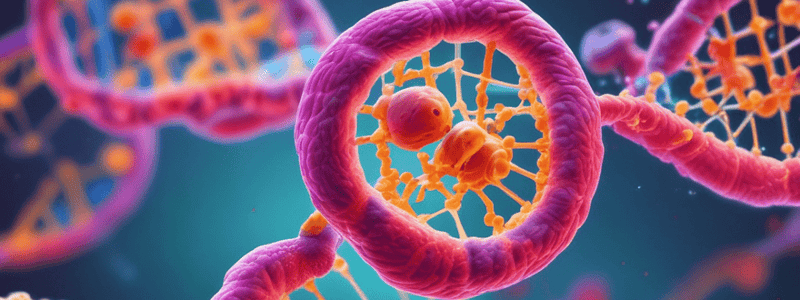Podcast
Questions and Answers
Which of the following correctly describes the relationship between histones and DNA?
Which of the following correctly describes the relationship between histones and DNA?
- Histones are RNA molecules that facilitate transcription by modifying DNA structure.
- Histones are proteins that fold DNA into nucleosomes, allowing for condensation of genetic material. (correct)
- Histones are non-homologous to nucleosomes and do not interact with DNA.
- Histones are structures found in bacteria that serve a similar purpose to nucleosomes.
What is the significance of histone modifications, such as acetylation and methylation?
What is the significance of histone modifications, such as acetylation and methylation?
- They determine the frequency at which a gene is transcribed, but do not affect its activation or repression.
- They alter the folding pattern of DNA around the histone core, affecting gene expression. (correct)
- They are required for the removal of nucleosomes from DNA, facilitating transcription.
- They change the physical structure of the histone proteins, but have no effect on gene expression.
Which of the following statements about histone marks is true?
Which of the following statements about histone marks is true?
- You don't need to know specific histone marks for understanding gene regulation.
- Histone marks are circular structures that help organize DNA into nucleosomes.
- H3K27me3 is a repressive mark, typically found in transcriptionally inactive regions of the genome. (correct)
- H3K27ac and H3K4me3 are always associated with active transcription, regardless of cell type or developmental stage.
Which of the following best describes the relationship between cell division and chromosome organization?
Which of the following best describes the relationship between cell division and chromosome organization?
What is the purpose of sister chromatids in cell division?
What is the purpose of sister chromatids in cell division?
Which of the following best describes the relationship between histones and nucleosomes?
Which of the following best describes the relationship between histones and nucleosomes?
What is the significance of the different phases of the cell cycle?
What is the significance of the different phases of the cell cycle?
Which of the following statements about chromosome structure during cell division is correct?
Which of the following statements about chromosome structure during cell division is correct?
Flashcards are hidden until you start studying
Study Notes
Histones and DNA Relationship
- Histones are proteins that package and organize DNA into structural units called nucleosomes.
- DNA wraps around histones, aiding in the compaction and protection of genetic material.
Significance of Histone Modifications
- Histone modifications, including acetylation and methylation, regulate gene expression by altering chromatin structure.
- Acetylation typically promotes gene activation by loosening chromatin; methylation can either repress or activate genes, depending on context.
Histone Marks
- Histone marks are specific chemical modifications on histones that serve as signals for transcriptional regulation and chromatin organization.
- The accuracy and recognition of histone marks are crucial for maintaining cellular identity and function.
Cell Division and Chromosome Organization
- During cell division, chromosomes undergo condensation to facilitate segregation, ensuring each daughter cell receives the correct genetic information.
- Proper chromosome organization is essential for accurate DNA replication and distribution to new cells.
Purpose of Sister Chromatids
- Sister chromatids, formed during DNA replication, provide a backup copy of genetic information, ensuring redundancy during cell division.
- They are essential for equitable distribution of genetic material during mitosis and meiosis.
Histones and Nucleosomes Relationship
- Nucleosomes consist of a core of histones around which DNA is tightly coiled, forming a fundamental unit of chromatin architecture.
- This organization reduces the DNA's length and enables more compact storage in the cell nucleus.
Significance of Cell Cycle Phases
- The cell cycle comprises distinct phases (G1, S, G2, and M) that regulate cell growth, DNA replication, and division.
- Each phase has specific checkpoints to verify proper progression, preventing errors and maintaining genomic stability.
Chromosome Structure During Cell Division
- During mitosis, chromosomes become highly condensed, allowing them to be separated efficiently; they revert to less condensed forms post-division.
- The structural changes in chromosomes facilitate accurate segregation and minimize the risk of genetic material loss or damage.
Studying That Suits You
Use AI to generate personalized quizzes and flashcards to suit your learning preferences.




